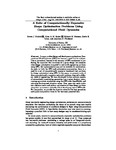A suite of computationally expensive shape optimisation problems using computational fluid dynamics
| dc.contributor.author | Daniels, SJ | en |
| dc.contributor.author | Rahat, AAM | en |
| dc.contributor.author | Everson, RM | en |
| dc.contributor.author | Tabor, GR | en |
| dc.contributor.author | Fieldsend, JE | en |
| dc.date.accessioned | 2018-10-29T09:21:57Z | |
| dc.date.available | 2018-10-29T09:21:57Z | |
| dc.date.issued | 2018-08-21 | en |
| dc.identifier.isbn | 9783319992587 | en |
| dc.identifier.issn | 0302-9743 | en |
| dc.identifier.uri | http://hdl.handle.net/10026.1/12661 | |
| dc.description.abstract |
© 2018, Springer Nature Switzerland AG. In many product design and development applications, Computational Fluid Dynamics (CFD) has become a useful tool for analysis. This is particularly because of the accuracy of CFD simulations in predicting the important flow attributes for a given design. On occasions when design optimisation is applied to real-world engineering problems using CFD, the implementation may not be available for examination. As such, in both the CFD and optimisation communities, there is a need for a set of computationally expensive benchmark test problems for design optimisation using CFD. In this paper, we present a suite of three computationally expensive real-world problems observed in different fields of engineering. We have developed Python software capable of automatically constructing geometries from a given decision vector, running appropriate simulations using the CFD code OpenFOAM, and returning the computed objective values. Thus, users may easily evaluate a decision vector and perform optimisation of these design problems using their optimisation methods without developing custom CFD code. For comparison, we provide the objective values for the base geometries and typical computation times for the test cases presented here. | en |
| dc.format.extent | 296 - 307 | en |
| dc.language.iso | en | en |
| dc.title | A suite of computationally expensive shape optimisation problems using computational fluid dynamics | en |
| dc.type | Conference Contribution | |
| plymouth.volume | 11102 LNCS | en |
| plymouth.journal | Lecture Notes in Computer Science (including subseries Lecture Notes in Artificial Intelligence and Lecture Notes in Bioinformatics) | en |
| dc.identifier.doi | 10.1007/978-3-319-99259-4_24 | en |
| plymouth.organisational-group | /Plymouth | |
| plymouth.organisational-group | /Plymouth/Faculty of Science and Engineering | |
| plymouth.organisational-group | /Plymouth/REF 2021 Researchers by UoA | |
| plymouth.organisational-group | /Plymouth/REF 2021 Researchers by UoA/UoA11 Computer Science and Informatics | |
| dcterms.dateAccepted | 2018-05-14 | en |
| dc.rights.embargodate | 2019-10-19 | en |
| dc.identifier.eissn | 1611-3349 | en |
| dc.rights.embargoperiod | Not known | en |
| rioxxterms.versionofrecord | 10.1007/978-3-319-99259-4_24 | en |
| rioxxterms.licenseref.uri | http://www.rioxx.net/licenses/all-rights-reserved | en |
| rioxxterms.licenseref.startdate | 2018-08-21 | en |
| rioxxterms.type | Conference Paper/Proceeding/Abstract | en |


